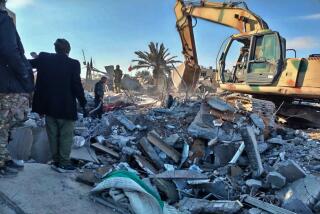Air War Has Detractors but Can Prove Crucial
- Share via
WASHINGTON — Opposition fighters hoping to capture the strategic Afghan city of Mazar-i-Sharif have been emboldened by the U.S. bombardment of Taliban troops, but past air campaigns indicate that efforts to kill dispersed and hidden soldiers before a major ground war bring limited success.
Since last week, the U.S.-led air attack has focused on front-line Taliban soldiers and is “going quite well,” Defense Secretary Donald H. Rumsfeld said this week. But bombardments from World War II to Yugoslavia suggest that Taliban casualties will probably increase dramatically only after an extensive ground offensive draws soldiers out of their caves and urban bivouacs and into the sights of U.S. bombers, military analysts say.
That could leave opposition Northern Alliance fighters launching key attacks without knowing whether they remain heavily outnumbered by Taliban forces.
Yet even without killing large numbers of troops, the air war could be critical to the success of the campaign, Pentagon strategists and military analysts say. The NATO assault against Yugoslavia in 1999 forced Serbian troops to hide their tanks under trees and in buildings rather than use them. The incessant pounding of Iraqi positions in the 1991 Persian Gulf War killed perhaps one in three soldiers but prompted thousands more to flee the battle.
Pentagon officials acknowledge that they can’t quantify the Taliban’s troop losses, particularly when hundreds of volunteer Pakistani reinforcements are reportedly crossing into Afghanistan. But Taliban forces and militants with the Al Qaeda terrorist network who evade the bombings may find it difficult to attack the Northern Alliance while under fire. More important, Pentagon officials say, less committed warlords and Taliban conscripts might be tempted to change sides.
“There’s no doubt in my mind that bombing destroyed the will of Iraqi soldiers . . . to fight,” said Clark Murdoch, a former Air Force deputy director of strategic planning who is now a senior fellow at the Center for Strategic and International Studies.
Having started the war in Afghanistan targeting airfields, communications and other control sites, U.S. bombers have turned their attention to Taliban fighters in caves, tunnels and trenches. Of the 80 U.S. air missions flown Tuesday, for example, two-thirds rained down on Taliban forces, Marine Gen. Peter Pace said at a Pentagon briefing. The remainder targeted caves and tunnel complexes believed to conceal other troops and equipment.
A debate persists in the military over the virtues of air assaults. Some analysts believe that the airborne attacks in Iraq and Yugoslavia were successful only because they were backed by the threat of a ground war. One senior Pentagon official drew a parallel to the example that Pentagon strategists hope not to repeat.
“We bombed the North Vietnamese for years with no effect,” he said, speaking on condition of anonymity. “It’s not a perfect solution.”
When the bombing in Afghanistan began, the Taliban was estimated to have 45,000 to 65,000 troops. Estimates for the Northern Alliance ranged from 15,000 to 30,000.
Asked to quantify Taliban losses earlier this week, Rear Adm. John D. Stufflebeem said, “Because this is enemy territory, it’s very difficult to get reliable information out.” But he cited media reports and the lack of return fire in some areas as evidence of “substantial losses.”
Russian military officials have passed on intelligence, pointing out caves and other facilities that had been used during the Soviet occupation of Afghanistan. Other information appears to come from photos taken by satellites, spy jets and U.S. Special Forces on the ground.
“If we had good intelligence, we would be using it presumably to get at our target, which is Osama bin Laden and Al Qaeda--not to check how our ‘daisy cutters’ are faring,” said Ivo H. Daalder, a senior fellow in foreign policy studies at the Brookings Institution, referring to a Vietnam-era bomb that has been used in Afghanistan.
As the Afghan military campaign approaches its sixth week, Brookings Institution defense analyst Michael O’Hanlon noted that the 40-day air assault in Iraq reduced enemy troops and equipment by about 1% a day, later studies showed. The 1999 NATO assault on Serbia lasted 11 weeks but destroyed less than 40% of Serbian heavy weaponry, at a rate about half a percent a day.
“I would . . . guess that we’re going to do considerably less than 1% a day, adjusting for the conditions in Afghanistan,” O’Hanlon said.
Policymakers acknowledge the limits of air power. With aerial bombardments alone, “you’re not going into the caves and getting the troops out,” said an Arab official whose nation is part of the U.S.-led coalition against terrorism.
He noted that even if airstrikes kill half the troops arrayed against the Northern Alliance, the Taliban forces still could have superior numbers.
A ground assault such as the Northern Alliance’s expected effort to capture Mazar-i-Sharif can alter that ratio more quickly, said Murdoch, the former Air Force planner.
“When you get your [Taliban] forces moving, they become much more vulnerable,” he said. “They’re gathering, they’re moving on roads, they can be found by our remote sensing and other intelligence assets.”
The secondary benefits of bombing troops can be substantial, analysts say. The daily pounding of air assaults gives the Northern Alliance time to prepare its ground assault, according to the experts.
Other results are less tangible. In an Air Force-sponsored review of the 1991 Persian Gulf War airstrikes, Eliot A. Cohen of the Johns Hopkins School of Advanced International Studies said many second-tier effects weren’t appreciated at the time.
“One of the things we found,” he said, “was that even if you don’t hit the tank, the fact that they’re afraid to go near it means people stop maintenance on it and it doesn’t work so well.”
More to Read
Sign up for Essential California
The most important California stories and recommendations in your inbox every morning.
You may occasionally receive promotional content from the Los Angeles Times.













